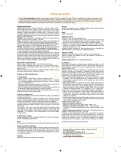Bulking agents in the treatment of the stress urinary incontinence - current state and future perspectives
Authors:
J. Krhut 1,2; P. Zvara 2,3; M. Gärtner 1
Authors‘ workplace:
Urologické oddělení FN, Ostrava, primář doc. MUDr. J. Krhut, Ph. D.
1; Katedra chirurgických oborů LF OU, Ostrava, přednosta doc. MUDr. P. Zonča, Ph. D., FRCS
2; Division of Urology, University of Vermont, Burlington, VT, USA
3; Gynekologicko-porodnická klinika FN, Ostrava, přednosta doc. MUDr. V. Unzeitig, CSc.
4
Published in:
Ceska Gynekol 2015; 80(2): 156-160
Overview
A review focused on minimally invasive treatment of the stress urinary incontinence using bulking agents provides a summary of the current knowledge on this subjects. This paper summarizes the findings on the mechanism of action, indications and applications technique, as well as clinical data on the efficacy and safety of the currently available bulking agents. Attention is also paid to possible future trends of this method. The work is designed to include specific implications for clinical practice.
Keywords:
urinary incontinence, bulking agents, urethra, urinary infection, voiding dysfunction
Sources
1. Abrams, P., Cardozo, L., Fall, M., et al. Standardisation Sub-Committee of the International Continence Society: The standardisation of terminology in lower urinary tract function: report from the standardisation sub-committee of the International Continence Society. Urology, 2003, 61, 1, p. 37–49.
2. Andersen, RCM. Long-term follow-up comparison of Durasphere™ and Contigen™ in the treatment of stress urinary incontinence. J Lower Genital Tract Dis, 2002, 6, 4, p. 239–243.
3. Appell, RA. Urethral and bladder injections for incontinence including botox. Urol Clin North Am, 2011, 38, 1, p. 1–6.
4. Elazyat, EA., Karsenty, G., Bismar, TA., Corcos, J. Volume changes and histological response to injected dextranomer/hyaluronic acid copolymer (Zuidex) and collagen (Contigen) in rats, Int Urogynaecol J Pelvic Floor Dysfunct, 2008, 19, p. 247–252.
5. Ghoniem, G., Corcos, J., Comiter, C., et al. Cross-linked polydimethyl siloxane injection for female stress urinary incontinence : results of a multicenter, randomized controlled, single-blind study. J Urol, 2009, 181, p. 204–210.
6. Hannestad, YS., Rortveit, G., Sandvik, H., Hunskaar, S. A community-based epidemiological survey of female urinary incontinence: the Norwegian EPINCONT study. Epidemiology of Incontinence in the County of Nord-Trondelag. J Clin Epidemiol, 2000, 53, 11, p. 1150–1157.
7. Herschorn, S. Current use of injectable agents for female stress urinary incontinence. Rev Urol, 2005, 7, Suppl. 1, p. S12–S21.
8. Herschorn, S., Radomski, SB. Collagen injections for genuine stress urinary incontinence: patient selection and durability. Int Urogynecol J, 1997, 8, p. 18–24.
9. Kirchin, V., Page, T., Keegan, PE., et al. Urethral injection therapy for urinary incontinence in women. Cochrane Database of Systematic Reviews, 2012, Issue 2, Art No: CD003881.
10. Martan, A., Masata, J., Svabík, K., Krhut, J. Transurethral injection of polyacrylamide hydrogel (Bulkamid®) for the treatment of female stress or mixed urinary incontinence. Eur J Obstet Gynecol Reprod Biol, 2014, 178, p. 199–202.
11. Martan, A., Mašata, J., Švabík, K. Vaginální tahuprosté páskové operace řešící stresový typ inkontinence moči u žen. Čes Gynek, 2012, 77, s. 299–304.
12. Martins, SB., Oliveira, E., Castro, RA., et al. Clinical and urodynamic evaluation in women with stress urinary incontinence treated by periurethral collagen injection. International Braz J Urol 2007, 33, 5, p. 695–703.
13. Monga, AK., Stanton, SL. Urodynamics: prediction, outcome and analysis of mechanism for cure of stress incontinence by periurethral collagen. Br J Obstet Gynaecol, 1997, 104, 2, p. 158–1627.
14. Mouritsen, L., Lose, G., Møller-Bek K. Long-term follow-up after urethral injection with polyacrylamide hydrogel for female stress incontinence. Acta Obstet Gynecol Scand, 2014, 93, 2, p. 209–212.
15. Murless, BC. The injection treatment of stress urinary incontinence. J Obstet Gynaecol Br Emp, 1938, 45, p. 67–73.
16. Nygaard, I., Thom, D., Calhoun, E. Urinary incontinence in women. In: Litwin, M, Saigal, C, eds. Urologic disease in America. Washington, DC: US Government Publishing Office, 2004, p. 71–103.
17. Peters, KM., Dmochowski, RR., Carr, LK., et al. Autologous muscle derived cells for treatment of stress urinary incontinence in women. J Urol, 2014, 192, 2, p. 469–476.
18. Rovner, ES., Goudelocke, CM. Which injectable to use in the treatment of intrinsic sphincter deficiency? Curr Opin Urol, 2010, 20, p. 296–301.
19. Schultz, JA., Nager, CW., Stanton, SL., et al. Bulking agents for stress urinary incontinence: short term results and complications in a randomized comparison of periurethral and transurethral injection. Int Urogynaecol J Pelvic Floor Dysfunct, 2004, 15, 4, p. 261–265.
20. Shortliffe, LM., Freiha, FS., Kessler, R., et al. Treatment of urinary incontinence by the periurethral implantation of glutaraldehyde cross-linked collagen. J Urol, 1989, 141, 3, p. 538–541.
21. Sokol, ER., Karram, MM., Dmochowski, R. Efficacy and safety of Bulkamid in the treatment of female stress urinary incontinence: A randomized prospective multicenter North-American study. J Urol, 2014, p. 10.
22. Strasser, H., Marksteiner, R., Margreiter, E., et al. Stamm-zelltherapie der Harninkontinenz. Urologe A, 2004, 10, S. 1237–1241.
23. Tunn, R., Goldammer, K., Gauruder-Burmester, A., et al. Pathogenesis of urethral funneling in women with stress urinary incontinence assessed by introitalultrasound. Ultrasound Obstet Gynecol, 2005, 26, 3. p. 287–292.
Labels
Paediatric gynaecology Gynaecology and obstetrics Reproduction medicineArticle was published in
Czech Gynaecology

2015 Issue 2
Most read in this issue
- Birth hypoxia
- Measurement of gestational sac volume in the first trimester of pregnancy
- Ovaria borderline tumor – fertility-sparing surgery; case report
- Specifics of medical care for lesbians
